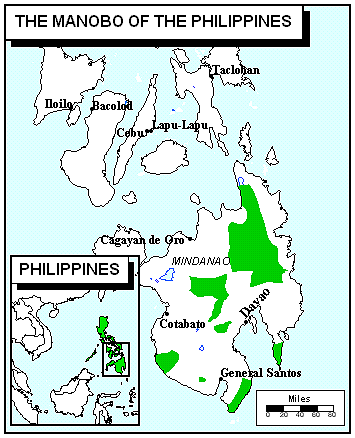The Manobo are several people groups who inhabit the island of Mindanao in the southern Philippines. They speak one of the languages belonging to the Manobo language family. Their origins harken back to the early Malay peoples who came from the surrounding islands of Southeast Asia. Today, their common cultural language and Malay heritage help to keep them connected.
The Manobo cluster includes eight groups: the Cotabato Manobo, Agusan Manobo, Dibabawon Manobo, Matig Salug Manobo, Sarangani Manobo, Manobo of Western Bukidnon, Obo Manobo, and Tagabawa Manobo. The groups are often connected by name with either political divisions or landforms. The eight Manobo groups are all very similar, differing only in dialect and in some aspects of culture. Often the distinctions have resulted from their geographical separation. In other cases, their name indicates their language. For example, the Dibabawon Manobo have that name because their language is Dibabawon.
Most Manobo people, including the Dibabawon Manobo, live an agricultural lifestyle. Their yields are hampered by outdated farming methods. Some use “slash and burn” agricultural methods, and they are running out of spare land to do this. They are highly dependent on rice, but they also grow sweet potatoes, corn and coconuts. They supplement their diet by fishing and hunting.
Social life for the Manobo is patriarchal (male-dominated). The head of the family is the husband. Polygyny (having more than one wife at a time) is common and is allowed according to a man's wealth.
The political aspects of life are often integrated with the social aspects. For example, many social events, such as weddings, require political leaders. Whenever there is a negotiation for marriage, both the bride and the groom must use the local datu (headman) to make all of the arrangements.
Their homes are usually rectangular. They have one room, which includes sections for cooking, sleeping, and socializing. They use bamboo and wood for most of the building. They build these to last for three to five years. Those who have to move to a new location because they use slash-and-burn agricultural techniques and take whatever they can to build a new home.
Both genders pierce their ears and many have tattoos.
Some of the Dibabawon Manobo are struggling with adapting to the outside world, while others have migrated to cities and embraced change. Their culture is in the process of undergoing change.
The religious beliefs of the Dibabawon Manobo revolve around many unseen spirits interfering in the lives of humans. They believe these spirits have human characteristics. Depending on how one treats these spirits, they can benefit you or oppose you.
While the religious practices of the Manobo vary slightly, there seems to be at least one common thread linking them together. Each Manobo culture believes in one "great spirit." This "great spirit" is usually viewed as the creator figure. They do not, however, offer rituals to the creator like they do for the unseen spirits.
The Manobo people have also been affected by outside religious beliefs such as Christianity. Unfortunately, they usually blend faith in Christ with their traditional beliefs. There are strong Christians among them.
There is always the temptation to blend faith in Christ with faith in the spirit world.
They must give all their devotion to the loving God who longs to make them a part of His family.
The Dibabawon Manobo need help increasing their crop yields. Their old ways of doing things will not allow them to have enough of a buffer crop.
Pray for the Lord to thrust out loving Christians with agricultural skills to help them produce an abundant harvest.
Pray for the Dibabawon Manobo to have the spiritual hunger it takes to put all their faith in Jesus Christ rather than traditional spirits.
Pray there will soon come a day when Dibabawon Manobo disciples will be discipling others.
Scripture Prayers for the Manobo, Dibabawon in Philippines.
https://en.wikipedia.org/wiki/Manobo
| Profile Source: Joshua Project |











